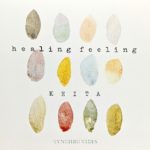
Oh, that healing feeling. Heaven knows I’ve been needing it more than usual, lately. Thankfully, I’ve had just the prescription for when life gives you some sour as hell lemons: Keita’s Healing Feeling. All is right in the world, for just 60 minutes, when I fire up the old laptop and hear Keita pitter-pattering about. It’s always an unique mix. Taking inspiration from Jamaican Nyabinghi drumming (please do check out the work of Ras Michael in The Sons Of Negus or as Dadawah, for a primer), Rastafarian spiritualism, and weaving it through Okinawan folklore, contemporary Zen New Age, plus this new thing called “environmental music/Kankyō Ongaku”, this Healing Feeling leaves the impression of something familiar but also of something divine untouched by horrible pretense. It is through the life blood of Brother Keita that we get to experience another slice of that Awa Muse sound.
Keita’s sole album with pioneering Japanese fourth world record label Awa Muse was the product of a journey of sorts. Born Keita Uino, presciently named after the famous African djembe musician who introduced a lot of Japan to Mali music, this Tokyoite grew up trained in the study of Japanese reed instruments. Somehow, some way, at some point in his life in the mid ‘80s, Keita decided to travel the world and experience culture he felt was neglected back home.
First came trips around the backwaters of Japan. Then, those encounters led him to expand his outlook further in East Asia. Sometime, around 1987, Utai found himself in Jamaica, in a Rastafarian community. With true Rastas, he inculcated himself in their musical and cultural tradition, acquiring percussion and breath techniques (one being from Augustus Pablo of all people!) derived from Nyabinghi songs. On one fateful day, a local drummer told him that Africa should be his next trip. Only there would he be able to truly expand on Nyabinghi education.
Traveling through Mali, in West Africa, Keita would expand his horizon, learning other, freer styles based on further African and Indian traditions. By then, Keita had been inspired to pick up other instruments like the kalimba, as well. When he set his sails back to Japan he landed on Hideaki Masago’s fledgeling Awa Records, home to other Japanese world music misfits.
In 1991, he contributed a solo work called “あけぼの (Akebono)”, to Awa Records’ first compilation album entitled Shio-No-Michi which roughly took inspiration from the old salt trading road connecting the users from the Pacific Ocean to central Japan. “あけぼの (Akebono)”, in its original, condensed form sounded exactly like the name implied: a musical tone poem as one would imagine freighting oneself across this land. Gorgeous flutes and droning reeds, seem to orbit around a plaintive, circular acoustic folk melody. Assorted percussion then comes in painting on the edges all sorts of lively, simulacrum, maybe a watery brook, far off wind chimes or bird call. Then, those Nyabinghi drums kick in and voila, this track ends that compilation in a way that feels panoramic and inviting.
Two years later, Keita would expand on this feeling, rightfully, recalling the “healing” part of Nyabinghi tradition and reinterpreting in these other forms he wanted to move with. 1993’s Healing Feeling at first appears like wayward cultural appropriation, paintings by Hideaki speak of giving thanks to Om Shiva and Jah Rastafari, as if both moved as one, as if Keita could fully understand what all that meant. Without listening, one would assume the worst. However, one listen opens you up to what Keita intriguingly pulls off genuinely.
Accompanied by Brother Ryuji (on rhythm guitar and assorted African percussion), Junji Dai (on bells and assorted percussion, Oki (from the Flower Wind Travelin’ Band on bass, further percussion and flute), and ending with Mon Kumagaya (on acoustic sound effects) and Kenji Sumiyoshi (field recorder, who captured all those meditative nature sounds in Amakusa), Keita would weave a fully fleshed vision of what his idea of healing music was.
Often quite quiet. Often quite bubbling. Healing Feeling took the esoterica of reggae through a rumination — prolonging the contemplative vibes, expanding its ideas via minimal, earthly movements. Here the music all flows like one piece, giving the appearance of a Nyabinghi round, even as songs like “アサのメザメ (Morning I Meditation)” give rise to punctuated moments where the meditation is more an active one than a cyclical version. On that song you hear dub-inspired sonics fill the deeper edges of Keita’s hypnotic bongo and vocalization dance. They retreated to Amakusa, in the furthest southern and western point of Japan, to get closer to the rural, tropical environment Keita experienced in Jamaica. There they found a parallel world to create this unlikely masterpiece.
It’s there, this vacillation between two experiences: the passive meditation and the active one, gives Healing Feeling it’s inspiring pull. Just one track prior, “レインダンス (Rain Dance)”, droplets of melody coalesce in a way that gently glides you along its song length. Then, the album ends on a reborn version of “あけぼの (Akebono)”, all the players taking cue from Keita to create a bigger picture, a canvas with richer colors, a palette that seems just about endless. You could use electronics to create something similar to this, but Healing Feeling is just another bit of life showing humanity has a way of willing its own inner energy through other conduits proven to give off better sonic vibrations.




